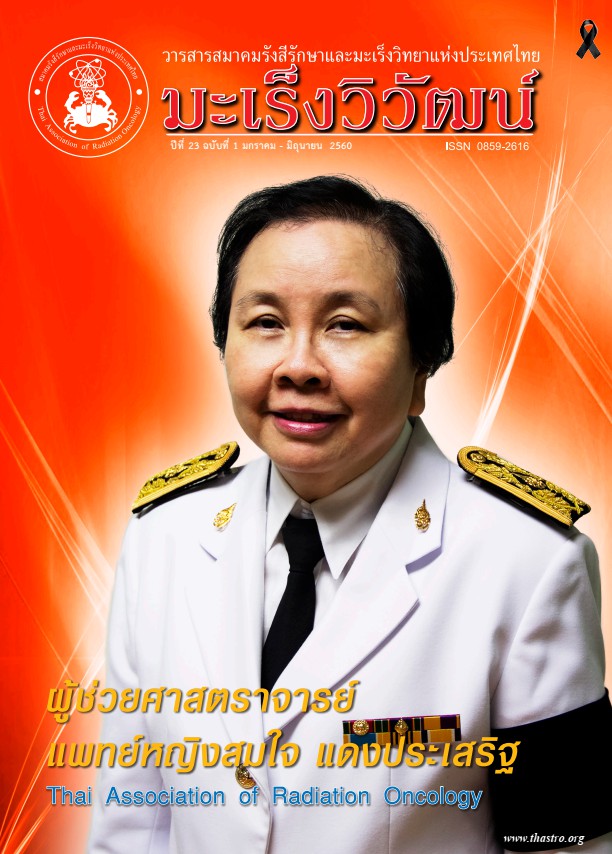Dosimetric Comparison of Stereotactic Radiotherapy Treatment Planning between Three Dimensional Conformal Radiation Therapy and Tomotherapy for Brain tumor
Keywords:
Stereotactic Radiotherapy, Helical Tomotherapy, Three-dimensional radiotherapy, Dosemetric parametersAbstract
Backgrounds: Stereotactic Radiotherapy (SRT) for brain tumor must have highly accuracy of radiation to get the maximum radiation dose to the lesions while organs at risk (OARs) receives the minimum radiation dose. The research found that the Helical Tomotherapy (HT) is used in SRT for brain tumor. The study was done retrospectively to plan and compare SRT with HT. Objective: To plan SRT with HT for brain tumor and compare dosemetric parameters of planning target volume (PTV) and OARs with three-dimensional radiotherapy (3DCRT) using a linac with micro-multileaf collimator. Materials and Methods: This is a retrospective study for SRT treatment planning comparison between HT and 3DCRT using a linac with micro-multileaf collimator. The CT images of 17 brain tumor cases who received SRT were used to generate HT planning. The comparison dosemetric parameters of PTV were conformity index (CI) and homogeneity index (HI). The OARs were brainstem, optic chiasm, optic nerves and eyes. The comparison dosemetrics parameters of OARs maximum dose (Dmax), minimum dose (Dmin) and mean dose (Dmean). The whole brain dose parameters were D50 and integral dose. Result: The result showed the CI of PTV were 1.15, 1.51 and the HI of PTV were 6.51%, 9.64% for HT and 3-DCRT, respectively. There were no statistically significant differences. For OARs, Dmax, Dmin and Dmean of brain stem, optic nerves and eyes in HT plan were higher than 3-DCRT plan. There were statistically significant differences of Dmax, Dmean at the eyes and Dmin at the optic nerves. However, Dmax and Dmin of the optic chiasm of HT were less than 3-DCRT but there was no statistically significant difference. For the whole brain, D50 and integral dose of HT plan were 0.4 and 3.32 Gy, respectively. Conclusion: The comparison of SRT treatment planning for Brain tumor, the HT plan showed better CI and HI of PTV than the 3-DCRT plan. The HT was an appropriate SRT technique for Brain tumor. Although the HT had low dose spread out to surrounding normal tissues, the normal tissue tolerance did not exceed.
References
อัตถพร บุญเกิด. โรคเนื้องอกสมอง (Brain tumor) [อินเทอร์เน็ต]. 2555 [เข้าถึงเมื่อ 1 เมษายน 2559]. เข้าถึงได้จากhttp://med.mahidol.ac.th/surgery/sites/default/files/public/ pdf/PDFneuro/4.pdf
Michael C. AAPM Report no.54 Stereotactic radiosurgery [Internet]. 1995 [cited 2016 March 15]. Available: https://www.aapm.org/ pubs/reports/RPT_54.pdf
Elia AE, Shih HA, Loeffler JS. Stereotactic radiation treatment for benign meningiomas. Neurosurg Focus.2007;23:E5.
Feuvret L, Noel G, Mazeron JJ, Bey P. Conformity index. Int J Radiat Oncol Biol Phys 2006; 64:333-42.
Yoon M, Park SY, Shin D, Lee SB, Hong RP, Kim DY, et al. A new homogeneity index based on statistical analysis of the dose-volume histograms. Am Coll Med Phys 2007; 8:9-17.
Arienzo MD, Masciullo SG, Sanctis VD, Osti MF, Chiacchiararelli L, Enrici RM. Integral Dose and Radiation-Induced Secondary Malignancies: Comparison between Stereotactic Body Radiation Therapy and Three-Dimensional Conformal Radiotherapy. Int J Environ Res Public Health. 2012;9:4223-40
Soisson ET, Tome WA, Richards GM, Mehta MP. Comparison of linac based fractionated stereotactic radiotherapy and tomotherapy treatment plans for skull-base tumors. Radiother Oncol 2006; 78:313-21.
Shim JB, Lee S, Cho SJ, Lee SH, Kim J, Kim J, et al. Comparison of linac-based fractionated stereotactic radiotherapy and tomotherapy treatment plans for intra-cranial tumors. Chinese Physics C 2010; 34:1768-74.
Nagai A, Shibamoto Y, Yoshida M, Wakamatsu K, Kikuchi Y. Treatment of Single or Multiple Brain Metastases by Hypofractionated Stereotactic Radiotherapy Using Helical Tomotherapy. Int J Mol Sci 2014; 15:6910-24.
Cozzi L, Clivio A, Bauman G, Cora S, Nicolini G, Pellegrini R. Comparison of advanced irradiation techniques with photons for benign intracranial tumours. Radiother Oncol 2006; 80:268-73.
Fogliata A, Clivio A, Nicolini G, Vanetti E, Cozzi L. Intensity modulation with photons for benign intracranial tumours: A planning comparison of volumetric single arc, helical arc and fixed gantry techniques. Radiother Oncol 2008; 89:254-62.
Downloads
Published
How to Cite
Issue
Section
License
บทความที่ได้รับการตีพิมพ์เป็นลิขสิทธิ์ของวารสารมะเร็งวิวัฒน์ ข้อความที่ปรากฏในบทความแต่ละเรื่องในวารสารวิชาการเล่มนี้เป็นความคิดเห็นส่วนตัวของผู้เขียนแต่ละท่านไม่เกี่ยวข้องกับ และบุคคลากรท่านอื่น ๆ ใน สมาคมฯ แต่อย่างใด ความรับผิดชอบองค์ประกอบทั้งหมดของบทความแต่ละเรื่องเป็นของผู้เขียนแต่ละท่าน หากมีความผิดพลาดใดๆ ผู้เขียนแต่ละท่านจะรับผิดชอบบทความของตนเองแต่ผู้เดียว




